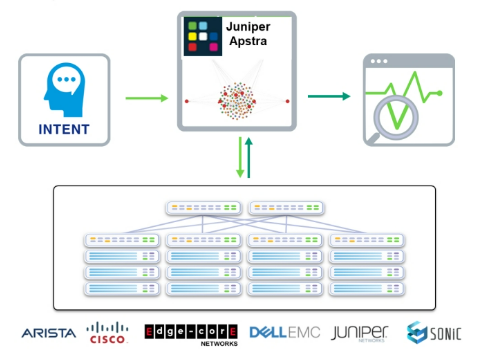EMAIL SUPPORT
dclessons@dclessons.comLOCATION
USDataCenter Automation - Juniper Apstra
Juniper Apstra is the Intent based Software Defined Network Solution , which enables Network Engineer to manage and configure their Data Center via Juniper Apstra Software. This Juniper Apstra Training provides knowledge to automate , manage Juniper or Data Center Switches via Juniper Apstra.
This Juniper Apstra Course also provides a comprehensive overview of Data Center design and Intent based Networking Concepts.
This Juniper Apstra Training Course covers Juniper Apstra architecture and its data center reference architecture including the designing, building, deploying, and automation of both a collapsed IP fabric and a three-stage IP fabric using a Virtual Extensible LAN (VXLAN) overlay.
Course Pedagogy :
- Describe what is meant by intent-based networking.
- Describe the Juniper Apstra architecture.
- Navigate the global Juniper Apstra UI.
- Configure role-based access control.
- Describe an IP fabric architecture.
- Explain VXLAN functions and operations.
- Describe Ethernet VPN (EVPN) routing and bridging.
- Describe the Juniper Apstra data center reference design.
- Describe IP fabric usage in the data center reference design.
- Describe host connectivity in the data center reference design.
- Describe the life cycle of the management of devices using Juniper Apstra.
- Create and use system agents to manage devices.
- Configure resources.
- Configure tags.
- Describe basic device abstractions used by Apstra.
- Describe logical devices.
- Describe device profiles.
- Describe interface maps.
- Configure a rack type.
- Configure templates.
- Build and deploy a blueprint.
- Navigate the blueprint UI.
- Perform basic fabric device operations and troubleshooting.
- Configure and apply property sets and configlets.
- Configure connectivity templates.
- Describe the multitenancy capabilities of Juniper Apstra
- Describe the purpose of root cause identification.
- Create and manage security policies.
- Describe the security policy functionality and terminology.
- Describe the security policy workflow.
- Describe the security policy conflict resolution.
- Describe management of security policies.
- Create a device profile.
- Create a logical device.
- Create an interface map.
- Add a spine and a rack to an existing blueprint.
- Add a generic system to an existing blueprint.
- Use the Graph Explorer to traverse the graph datastore.
- Describe the function of an IBA probe.
- Create an IBA probe.
- Configure logging to a remote syslog server.
- Describe how Apstra integrates with vCenter.
Juniper Apstra is an intent-based system because it provides a single console to manage a group of devices as a whole. We can interact with Apstra's single UI to deploy an IP fabric and monitor that fabric for our desired outcomes (link addressing, loopback addressing, BGP peering, and so much more). We can specifiy our intent once and enable the system to supply the agents with the information they need to build the right configurations for each device. It collects telemetry data from the devices (active configuration, BGP neighbors, LLDP relationships, and so on) and uses that data to verify that the network is operating as intended.

Juniper Apstra does not allow the operator to commit changes to the devices until it confirms that everything that you are attempting to do is a valid operation. Also, the Data Center reference design is a multivendor solution so Apstra can perform these checks in a mixed-vendor environment. Apstra supports all the common vendors, enabling you to make a choice of various vendor switches and operating systems. Juniper Apstra leverages standards-based protocols for interoperability. Juniper performs extensive software testing during the development process to ensure proper interoperability among the supported vendors.
Juniper Apstra does not have to be used as a single solution for everything in the data center. You can use it for a small portion, like a few racks or several rows, but we typically want to build the network with Juniper Apstra from the very beginning. Juniper Apstra can manage multiple data centers and any linkage you might need between multiple blueprints. Also, we give you the ability to support legacy workloads with things like Layer 2 connectivity between hosts or Layer 2 mobility across the entire data center fabric.
Juniper Apstra focuses on solving the big problems that are encountered when operating systems of any scale. Apstra provide tools for controlling how these systems perform and act. There are people in the network industry that are content with using open-source tools to automate common things like SNMP strings, messages of the day, and other aspects that are not really the challenging part of automation. These aspects are important and whatever strategy you choose to use must accommodate them. Juniper Apstra has taken on the more troublesome parts of automation.
Apstra automates the entire network including complex features while enabling mission-critical applications. Operating a network fabric that comprises Virtual Extensible LAN (VXLAN), BGP with Ethernet VPN (EVPN), and has many isolated tenants is a serious endeavor. There are so many moving parts and tiny details in such an environment. Automating the small things is helpful, but it's just a starting point into what automation can accomplish. Apstra can do this by making you create abstractions for all the intricate elements of you network which, in turn, enables Apstra to manage all the difficult details.




LEAVE A COMMENT
Please login here to comment.